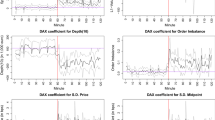Abstract
This papers examines the connection between the trading market and liquidity in a simple model with informed and uninformed traders. When agents in the market have plenty of information, assets are traded frequently. However, when news arrives the informed trader behaves as predator making profit from that news, this in turn leading to sudden drops in liquidity which I refer to as liquidity drops.
Similar content being viewed by others
References
Al Janabi, M. A. (2013). Optimal and coherent economic-capital structures: Evidence from long and short-sales trading positions under illiquid market perspectives. Annals of Operations Research, 205(1), 109–139.
Allen, F., & Gale, D. (1998). Optimal financial crises. The Journal of Finance, 53(4), 1245–1284.
Amendinger, J., Imkeller, P., & Schweizer, M. (1998). Additional logarithmic utility of an insider. Stochastic Processes and Their Applications, 75(2), 263–286.
Back, K. (1992). Insider trading in continuous time. The Review of Financial Studies, 5(3), 387–409.
Back, K. (1993). Asymmetric information and options. The Review of Financial Studies, 6(3), 435–472.
Bahaj, S., & Malherbe, F. (2018). The forced safety effect: How higher capital requirements can increase bank lending.
Basel III, BCBS. (2013). The liquidity coverage ratio and liquidity risk monitoring tools. Bank for International Settlements.
Carlin, B. I., Lobo, M. S., & Viswanathan, S. (2007). Episodic liquidity crises: Cooperative and predatory trading. The Journal of Finance, 62(5), 2235–2274.
Christensen, K., Oomen, R. C., & Renò, R. (2018). The drift burst hypothesis. Available at SSRN 2842535.
Das, S. R., & Hanouna, P. (2010). Run lengths and liquidity. Annals of Operations Research, 176(1), 127–152.
Delbaen, F., & Schachermayer, W. (1994). A general version of the fundamental theorem of asset pricing. Mathematische Annalen, 300(1), 463–520.
Dermine, J. (2015). Basel iii leverage ratio requirements and the probability of bank runs. Journal of Banking and Finance, 53, 266–277.
Diamond, D. W., & Dybvig, P. H. (1983). Bank runs, deposit insurance, and liquidity. Journal of Political Economy, 91(3), 401–419.
Duffie, D. (2017). Financial regulatory reform after the crisis: An assessment. Management Science, 64(10), 4835–4857.
Grorud, A., & Pontier, M. (1998). Insider trading in a continuous time market model. International Journal of Theoretical and Applied Finance, 1(03), 331–347.
Imkeller, P., Pontier, M., & Weisz, F. (2001). Free lunch and arbitrage possibilities in a financial market model with an insider. Stochastic Processes and Their Applications, 92(1), 103–130.
Jacklin, C. J., & Bhattacharya, S. (1988). Distinguishing panics and information-based bank runs: Welfare and policy implications. Journal of Political Economy, 96(3), 568–592.
Jacod, J. (1985). Grossissement initial, hypothèse (h’) et théorème de girsanov. In Grossissements de filtrations: exemples et applications, pp. 15–35. Springer.
Jeulin, T. (2006). Semi-martingales et grossissement d’une filtration (Vol. 833). Berlin: Springer.
Jeulin, T., & Yor, M. (1978). Grossissement d’une filtration et semi-martingales: formules explicites. In Séminaire de Probabilités XII, pp. 78–97. Springer.
Kyle, A.S. (1985). Continuous auctions and insider trading. Econometrica: Journal of the Econometric Society, pp. 1315–1335.
Malherbe, F. (2014). Self-fulfilling liquidity dry-ups. The Journal of Finance, 69(2), 947–970.
Morelli, G. (2018). Bounds for the supremum of mean reverting fractional processes. LUISS University.
Morris, S., & Shin, H. S. (2009). Illiquidity components of credit risk. Princeton University.
Nualart, D. (1995). The Malliavin calculus and related topics. New York: Springer.
O’hara, M., (1995). Market microstructure theory (Vol. 108). Cambridge: Blackwell Publishers.
Pikovsky, I., & Karatzas, I. (1996). Anticipative portfolio optimization. Advances in Applied Probability, 28(4), 1095–1122.
Pikovsky, I., & Karatzas, I. (1997). Market equilibrium with differential information. New York: Preprint, Columbia University.
Rösch, C. G., & Kaserer, C. (2013). Market liquidity in the financial crisis: The role of liquidity commonality and flight-to-quality. Journal of Banking and Finance, 37(7), 2284–2302.
Shleifer, A., & Vishny, R. (2011). Fire sales in finance and macroeconomics. Journal of Economic Perspectives, 25(1), 29–48.
Sun, E. W., Kruse, T., & Chen, Y.-T. (2019). Stylized algorithmic trading: Satisfying the predictive near-term demand of liquidity. Annals of Operations Research,. https://doi.org/10.1007/s10479-019-03150-0.
Yor, M. (1985a). Entropie d’une partition, et grossissement initial d’une filtration. In Grossissements de filtrations: exemples et applications, pp. 45–58. Springer.
Yor, M. (1985b). Inégalités de martingales continues arrêtées à un temps quelconque. In Grossissements de filtrations: exemples et applications, pp. 110–146. Springer.
Author information
Authors and Affiliations
Corresponding author
Additional information
Publisher's Note
Springer Nature remains neutral with regard to jurisdictional claims in published maps and institutional affiliations.
I am indebted to Roy Cerqueti and Rita D’Ecclesia. I thank Carol Alexander, Christian Brownlees, Damiano Brigo, Maria Chiarolla, Xavier Freixas, Eulalia Nualart, Alessio Sancetta, Paolo Santucci de Magistris, Marco Scarsini and a reviewer for insightful comments and suggestions that improved the quality of this work.
Rights and permissions
About this article
Cite this article
Morelli, G. Liquidity drops. Ann Oper Res 299, 711–719 (2021). https://doi.org/10.1007/s10479-019-03285-0
Published:
Issue Date:
DOI: https://doi.org/10.1007/s10479-019-03285-0




